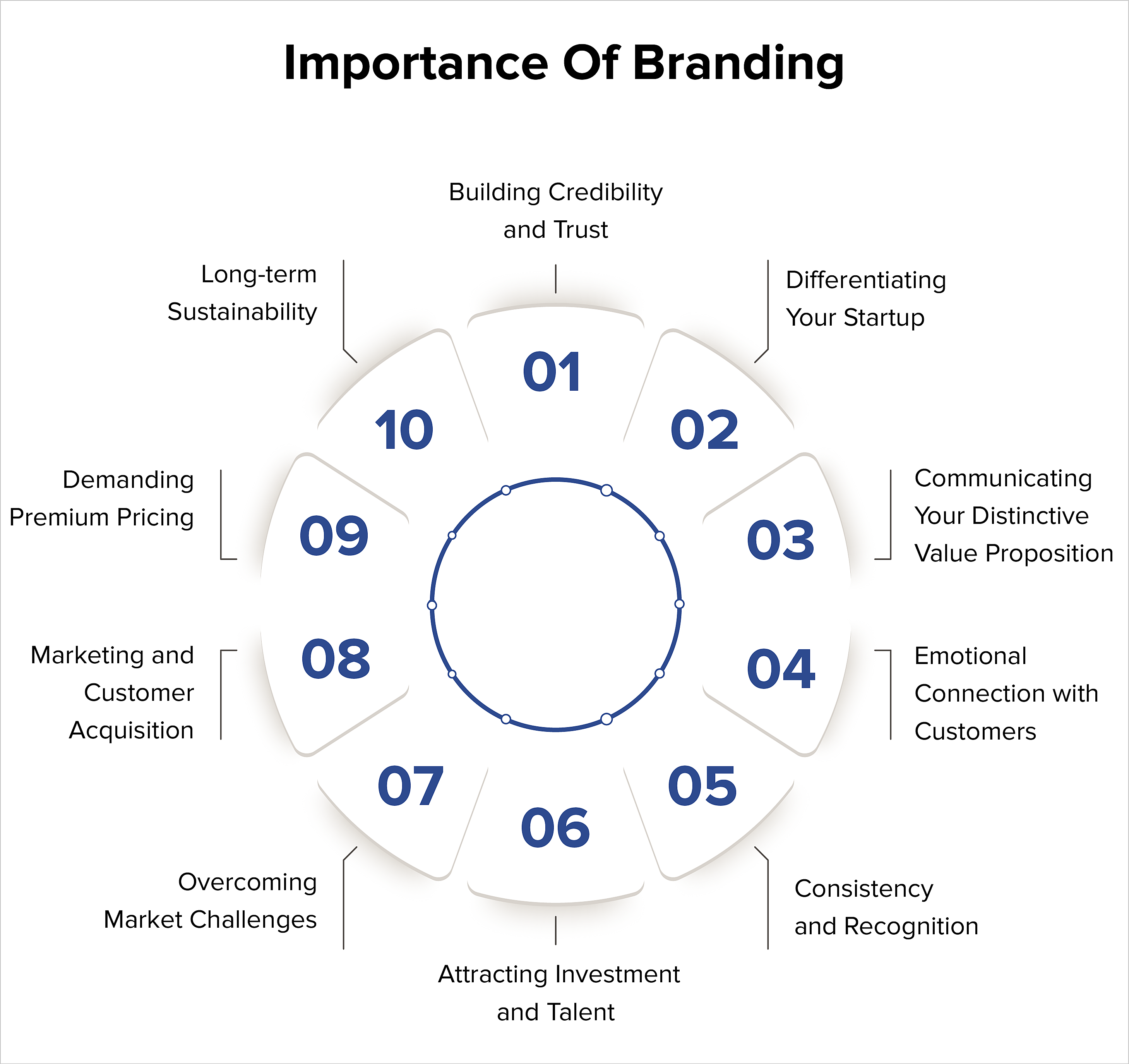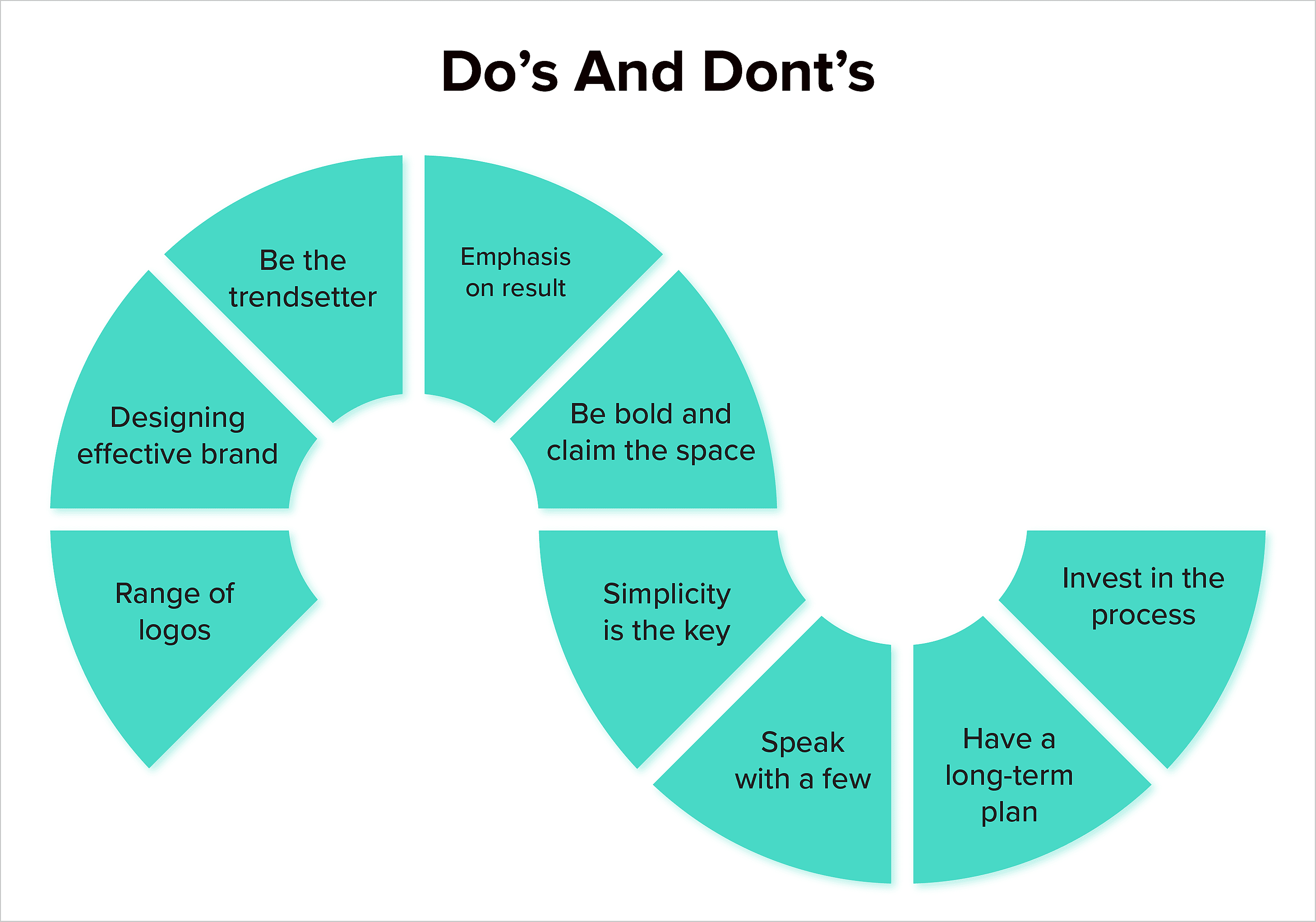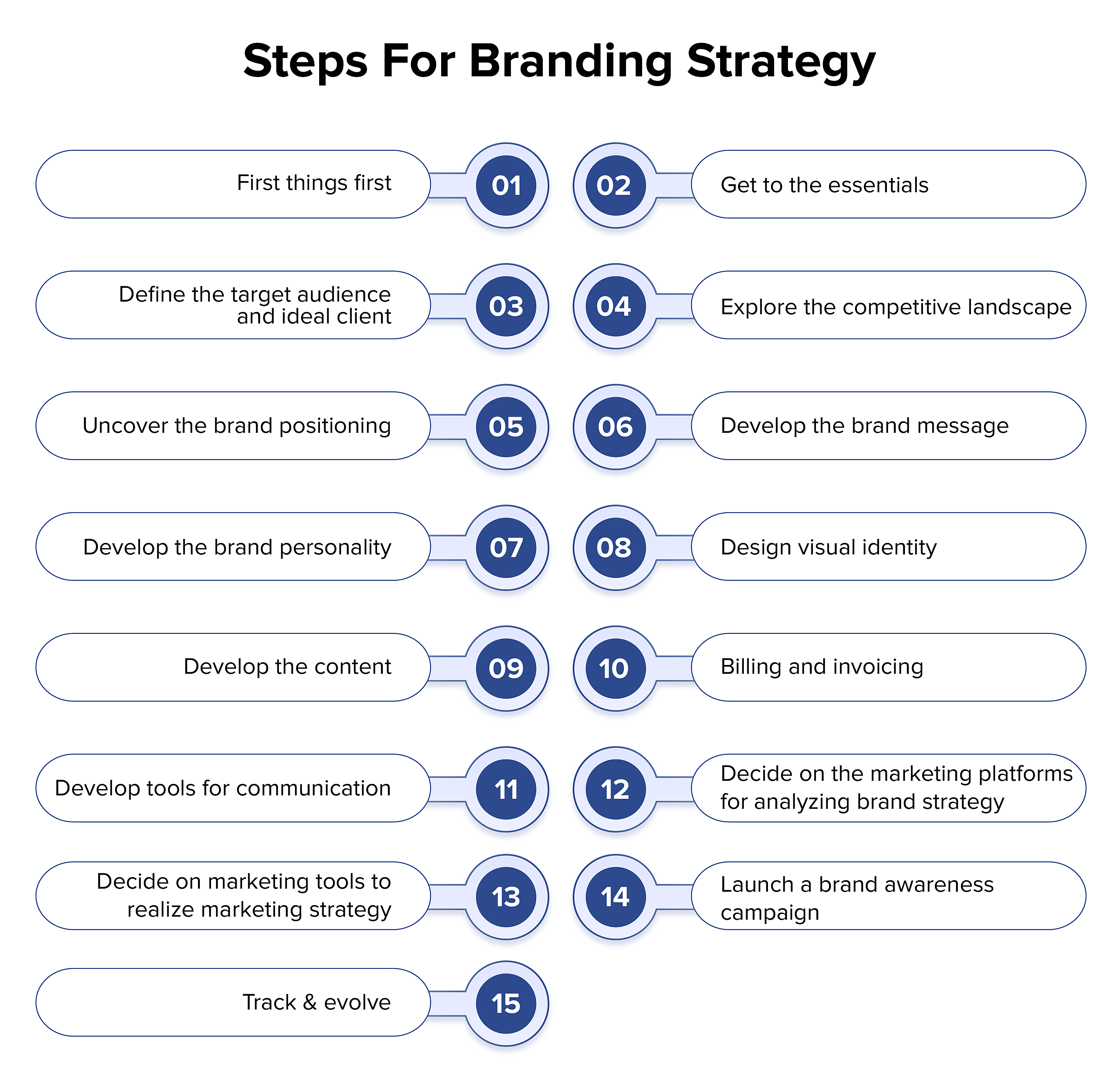
- What Is Branding?
-
The Significance of Startup Branding
- Building Credibility and Trust
- Differentiating Your Startup
- Communicating Your Distinctive Value Proposition
- Emotional Connection with Customers
- Consistency and Recognition
- Attracting Investment and Talent
- Overcoming Market Challenges
- Marketing and Customer Acquisition
- Demanding Premium Pricing
- Long-term Sustainability
-
Guiding Principles for Effective Business Branding: The Dos and Don'ts
- DON’T have just one logo → DO have a range of logos
- DON’T design a brand for you → DO design it with them in mind
- DON'T be trendy → DO be your trendsetter
- DON'T focus on the solution → DO focus on the result
- DON'T take the easy route → DO be bold and claim your space
- DON’T over complicate things → DO keep things simple
- DON’T speak to everyone → DO speak to a select few
- DON’T just plan for tomorrow → DO think long-term
- DON'T rush the process → DO invest in the process
- Components Of Successful Strategy For The Branded Startup
-
Starting Your Startup Branding Strategy
- Step 1 – First things first
- Step 2 – Get to the essentials
- Step 3 – Define the target audience and ideal client
- Step 4 – Explore the competitive landscape
- Step 5 - Uncover the brand positioning
- Step 6 – Develop the brand message
- Step 7 – Develop the brand personality
- Step 8 – Design visual identity
- Step 9 – Develop the content
- Step 10 – Develop tools for communication
- Step 11 – Decide on the marketing platforms for analyzing brand strategy
- Step 12 – Decide on marketing tools to realize marketing strategy
- Step 13 - Launch a brand awareness campaign
- Step 14 – Track and evolve
- Forging a Lasting Impression: Conclusion on Startup Branding Dos and Don'ts

Creating a unique brand identity is crucial in startups' competitive, fast-paced world. As the public face of your company, your brand embodies its values, guarantees, and uniqueness.
This article will go over the basic dos and don'ts of startup branding to guide you through the challenging process of creating a memorable and effective brand. Making a brand that resonates with your target audience, communicates your distinct value, and is consistent across several touchpoints is a wonderful stand-out approach, even though it can be challenging.
Understanding these core ideas can help you obtain a competitive edge, cultivate client loyalty, and make a lasting impression on your audience- whether starting as an entrepreneur or trying to update your brand. Come along as we examine the science and art of startup branding, revealing the tactics that succeed and the traps to watch out for.
What Is Branding?
Branding creates a unique product, service, or business identity. It encompasses developing a distinctive name, design, symbol, and voice that sets an offering apart from others in the market. Effective mobile app branding involves the aesthetic elements and customer experience with the brand. It's about building a reputation, fostering recognition, and establishing trust with the target audience.
Branding conveys a company's values, benefits, and personality through consistent messaging and visual elements. It's a strategic tool that, when executed well, can lead to customer loyalty, competitive advantage, and an elevated perceived value of the products or services offered. Branding is about shaping perceptions and creating an emotional connection with consumers. Now, let's explore how branding plays a crucial role in the Three Stages of a Startup - the ideation stage, growth stage, and scaling stage. When looking to establish a strong brand identity, consider seeking expert guidance from the 10 Best startup consulting firms to ensure your startup's branding efforts yield optimal results.
The Significance of Startup Branding
Why does startup branding matter so much? According to 77% of consumers, brand names influence their purchase decisions.

Studies reveal a strong correlation between a company's success and brand value. Up to 19.5% of a company's total financial worth is derived from its brand value. Even among products of comparable quality, a greater brand preference in a category can attract a 26% price premium.
In the dynamic world of startups, branding is more than just an aesthetic touch—it's a critical business decision. It is the foundation of your company's identity and has the power to build or break your enterprise. Here, we examine the strong arguments that make branding essential for new businesses.
1. Building Credibility and Trust
Customers frequently choose companies they know and believe in a market full of options. A strong brand establishes credibility and encourages trust, reassuring potential clients that your startup is a reputable, capable, and professional option. To consider purchasing, 81% of consumers must trust a brand.
2. Differentiating Your Startup
There is intense competition in startup environments because they are brimming with innovation. A powerful brand makes your company stand out from the competition and makes it simpler for potential clients to recall and select you over rivals. Learn how to build generative AI startups following several tips and strategies.
3. Communicating Your Distinctive Value Proposition
Your brand is a platform for highlighting the features that make your startup stand out. It summarizes your unique value proposition (UVP) and explains to your target market why your product or service is the best option.
4. Emotional Connection with Customers
Branding enables you to connect emotionally with your audience beyond merely offering goods or services. When building a brand narrative, remember that core values can connect with your target audience and foster a kind of enduring devotion beyond simple business dealings.
5. Consistency and Recognition
Consumers can quickly identify and recall your startup when your brand is consistent throughout all touchpoints, including your website, social media accounts, packaging, and customer support. Developing enduring relationships with customers depends on this brand awareness.
6. Attracting Investment and Talent
Strong brands indicate a startup's potential for growth and market viability, so investors are more likely to support them. A strong brand can also draw in top talent that shares the goals and values of your firm.
7. Overcoming Market Challenges
Startups can better weather market turbulence and adjust to changes with the support of a strong brand. It provides a strong basis for strategic reorientations while upholding essential brand attributes.
8. Marketing and Customer Acquisition
A strong brand streamlines marketing initiatives. It lowers the cost of acquiring new customers by facilitating more focused and successful marketing efforts that boost conversions. Customers are more than twice as likely to support businesses they believe in, buy first, and remain devoted to them.
9. Demanding Premium Pricing
You can charge more for your goods or services if you have a reputable brand. Consumers are frequently prepared to spend extra for a brand they believe to be reliable and of excellent quality.
10. Long-term Sustainability
Branding is an essential component of a successful business's long-term planning strategy. Building a brand makes it possible for your firm to withstand changes in the market and keep its base of devoted customers.
Guiding Principles for Effective Business Branding: The Dos and Don'ts
Are you wondering how to do branding for a startup? Before you create a brand, remember a few key things that can help all large and small businesses bring their brands to life. Think of this as a little crash course on purposeful start up branding.

1. DON’T have just one logo → DO have a range of logos
When it comes to startup branding, one typical error to avoid is having a single, rigid logo. The visual anchor of your brand is its logo, which needs to be adjusted for different platforms and situations. Consider the settings where your logo will be used, such as a mobile app icon, social media profile picture, or website header. Complementing your brand identity with various logos gives you the much-needed diversity.
Several logo iterations make your business branding look great in various contexts without sacrificing readability. This adaptability guarantees that your brand is consistently memorable and instantly identifiable across all touchpoints. Regardless of the platform or media, a startup with various logos can maintain a strong and consistent brand presence.
For small app icons, for example, you might have a condensed version of your logo, a monochrome version for print materials, and a vertical or horizontal arrangement to accommodate various design specifications. With this strategy, your brand can remain distinctive while meeting the needs of the digital era. In conclusion, adopting a range of logo designs for your startup improves the recognition and adaptability of your brand rather than sticking with only one. Check the best AI logo generators and apps to design the best logo for your brand.
2. DON’T design a brand for you → DO design it with them in mind
One important "don't" in the world of start up branding is creating a brand purely based on personal taste. Small company owners frequently make this error. Your brand should aim to attract and keep your ideal clientele rather than please yourself. It's your brand that should speak to them, not you. Your brand identity may unintentionally hurt your organization if you fail to comprehend what your target audience looks for in a company like yours or what will give them confidence when selecting your goods or services.
Invest time in gaining a nuanced understanding of your ideal customer to avoid this pitfall. Use tools like customer personas to guide your process of developing a brand strategy for startups. Each element should be strategically designed to effectively connect with your target audience, from the choice of brand colors to the imagery and overall tone. It's not about what you like but what resonates with them. For example, Google created its 3D logo, which is now human and more fun, adding better UX for customers.
Developing a brand identity that truly resonates with your target market, boosts inquiries, and encourages conversions all depends on designing with your ideal clients in mind. To ensure your branding efforts align with your target audience's requirements and preferences, consider obtaining expert brand services if you need help creating a distinctive brand identity to improve your company. Recall that your company's success will ultimately depend on how satisfied and involved your consumers are. When looking for inspiration, exploring the Best Startup Websites to Inspire Your Own can provide valuable insights into effective branding strategies.
3. DON'T be trendy → DO be your trendsetter
When building your business brand marketing, it may be tempting to follow the newest trends, but it's important to avoid putting all your eggs in one fashionable basket. By their very nature, trends might result in only temporary gains. By sticking to a clearly defined brand strategy, you can seek to become a pioneer in your own right rather than just following them mindlessly.
Even though trends can be alluring, they may not be consistent with a company's basic identity and values, which can work against the brand. Being flexible without sacrificing the authenticity of your brand is crucial. When trends support your long-term objectives, you can take advantage of them and make sure your company gains from them rather than is influenced by them. You can offer top mobile app development trends and the latest trends in software development trends. This is made possible by having a strong brand strategy.
A strong foundation of great branding for startups is consistency. Concentrate on what helps your firm to increase brand awareness and loyalty. Choose a strategy that aligns with the philosophy and values of your brand, then follow through on it. Your branding efforts will be greatly enhanced, and your following will grow if you are consistent and real.
In short, take charge of your brand's development rather than merely following trends in brand marketing. You can build a devoted following of customers who value your dedication to consistency and authenticity by setting your trends and adhering to your brand's identity.
4. DON'T focus on the solution → DO focus on the result
Concentrating on the outcome rather than the solution is a major change in branding for startups strategy. While your product or service might solve a problem, the emotional effect and the observable outcomes will draw in customers. Essentially, your brand should vividly depict the emotions or outcomes that your clients will experience or attain when utilizing your good or service. It's the transforming and emotional element that connects with your audience.
Consider purchasing a plane ticket as an example. People don't purchase airline tickets to face an uncomfortable, lengthy ride in the air with strangers or to deal with airport security and baggage claim difficulties. The promise of visiting the location motivates them to buy tickets. In a similar spirit, your brand's story should revolve around the destination—in this case, the outcome—that your good or service provides.
Make a list of the secondary issues your company handles to execute this plan of company branding successfully. These are the deeper, more emotional subconscious issues your offering helps resolve. Customers are more inclined to spend their hard-earned money on these intangible elements since they are searching for the emotions and results connected to your brand. Your brand will be more interesting and accessible if it concentrates on the outcome rather than simply the solution and builds a deeper connection with your target audience. Businesses can learn how to design engaging chatbots for better customer interactions.
5. DON'T take the easy route → DO be bold and claim your space
You could be tempted to choose what is comfortable and known, going along the well-traveled route. The truth is, though, that being cautious won't help you stand out or become your ideal client's first option. In a crowded market, blending in means you risk being missed and not making your startup stand out.
Rather, have the courage to define your niche, make big plans, and explain why it's all important. Aim for optimal results while assuming prudent risks. These brands draw attention because they provide something new or give an old concept a fresh perspective.
"A good company branding strategy will force you to make difficult decisions," experts say. The benefits are similarly great, even if a considerable danger is involved. The appropriate individuals will notice you when you deliberately make your mark in the industry. These people are going to be very important in helping your brand succeed.
Think about the universal problem many people, including you, face: finding success and luring ideal customers in the online market. Your brand strategy can act as a guide, streamlining your messaging and optimizing your marketing initiatives to raise brand recognition and increase revenue. Accept the risk-taking strategy, and you'll discover it ultimately pays off.
6. DON’T over complicate things → DO keep things simple
Recall that simplicity is your ally rather than complexity when it comes to branding for start ups. Don't complicate things too much; make it simple and theme-focused. This suggests focusing your mission, messaging, and product offers around a central concept rather than implying that your brand should be simple. Your brand identity is subject to the same principles. To ensure consistency, specify the colors, fonts, and picture styles that make up your brand and create brand standards.
You'll discover that maintaining your brand and business becomes far more manageable when you simplify your approach. It's easy to manage your startup's expansion when you have a well-defined brand strategy and set of standards. Your objectives and procedures become more streamlined, increasing the overall effectiveness and efficiency of company branding.
Don't overly complicate things, then. Accept the influence of minimalism in your startup's design. It will help you establish a stronger connection with your audience and increase company branding recall. Your brand has a greater effect, and your path as a business owner becomes less intimidating when you concentrate on what counts. Businesses can learn about AI in marketing-gateway to higher customer engagement and revenue generation.
7. DON’T speak to everyone → DO speak to a select few
As the saying goes, when you try to be everything to everyone, you end up being nothing to anyone. It's important to avoid casting too wide for marketing and branding for startups. Strive to appeal to a small number of people instead. You may position your startup as an expert rather than a generalist and create the conditions for success by focusing on a smaller target audience and owning your domain.
There is a strong attraction to specialization. When a specialist provides a service or product—someone who exhibits competence and a thorough understanding of their particular needs—people are willing to pay extra for it. Speaking to a specific, limited audience demonstrates your ability to comprehend their particular problems and offer specialized solutions.
Write your marketing material, organize your offerings, and produce your content with a specific person in mind to put this idea into practice. You might give the impression that you are communicating directly to your audience by addressing this person's needs and desires. By drawing clients who value your particular knowledge, this individualized approach creates a stronger bond and helps your firm expand.
Hence, the "DO" is to speak with a small group directly, while the "DON'T" is to try to meet everyone. By doing this, you'll establish your startup as the industry authority in your field and draw in a devoted clientele that appreciates your specialization and offerings. Always try moving with the trends shaping customer engagement tech to know your audience better.
8. DON’T just plan for tomorrow → DO think long-term
It's critical to plan to prevent having to rebrand in the future. Without a long-term vision, concentrating just on the here and now, such as your next campaign or urgent offerings, may force you to constantly go back to the drawing board for a fresh strategy for branding for startups.
You see, the larger picture is what brand strategy is all about. It lets you consider your overall aims and leverage what you're doing now to move closer to those goals gradually. It's critical to understand that companies grow organically. You can avoid needless and expensive future rebranding by devoting your time to planning for this evolution now.
Thinking long-term puts your startup on a path that leads directly to its end goal. It's similar to setting out on a map and ensuring that every step you take will get you closer to your goal. This strategy saves you time and money and creates a strong, enduring brand identity that will stand the test of time and adapt to shifting market conditions.
Thus, keep in mind to prepare for the long-term success of your startup like the significance of user retention and strategies to improve it rather than focusing only on short-term gains. This insight will strengthen your brand and ensure it remains strong and relevant for many years.
9. DON'T rush the process → DO invest in the process
Long-term success is what every business owner wants, especially when it comes to branding. It may seem like a long time to wait six to eight weeks to build your brand, but that's because we're working on a detailed plan that will eventually result in a brand that constantly promotes your company. This entails creating a brand experience that consistently boosts sales and is hard to ignore.
Great things take time to accomplish. You have to put money into building a truly authentic brand that will help your business succeed. Consider the branding process to be your brand's kind of counseling. It's an educational process that makes your company the best version of itself by giving you the resources and know-how to increase leads, increase sales, and cultivate brand loyalty in the mobile phone market.
Therefore, if you rush this process, you'll probably have a brand that isn't as successful as it may be and doesn't live up to your aspirations. You may even have to start the entire process over again later, which will confuse your audience and derail you from moving forward with the momentum you could have had if you had done it correctly from the beginning. Thus, step back, invest in the procedure, and allow your brand the time to develop and succeed in the long run and learn from the best omnichannel marketing tips for mobile apps to follow.
Components Of Successful Strategy For The Branded Startup
Startup branding tactics differ because a multitude of factors impact its content. A company's strategy and tactics for achieving its marketing objectives may be significantly altered by factors such as niche, age, scale, the state of the industry, and the expectations of its ideal customer.
Nonetheless, several expert branding agencies concur—many of whom have built millions of successful internet enterprises—that a few essential elements must constantly be the center of attention. These are:
1. Core Values
They are the foundation for the organization's main goals, messaging, and ideology. They must, therefore, be precisely specified and seldom altered. The brand's voice, tone, and language. Your target audience communication strategy must be well-defined, uniform across all channels, and fully in line with the goals and essential values of the business.
2. Ideal Client
The ideal client's profile should be evident, much like basic principles. It represents a carefully chosen market niche. Consequently, to effectively target the demographic, the organization should adhere to it.
3. Brand Assurance
It makes sense to build on every element mentioned previously. It is the message that appeals to your intended audience and presents the company's principles in an easily understood manner. It should be straightforward, motivating, and pertinent to the mission and basic principles of the business.
4. Visual Identity
Studies show that beauty has a strong attraction to humans. It is who we are. Therefore, it should come as no surprise that all successful small businesses and large companies alike prioritize design and copywriting. Millions of dollars are even invested in that by some of them. Your brand should have an appealing aesthetic that appeals to your target market and is consistent across media. Businesses can also consider learning from mobile app design tips for newbies.
5. Brand Touchpoints
Every item or component that represents your brand identity and interacts with customers in any manner qualifies as a brand touchpoint that requires careful attention to detail. This covers a company's website, blog, email newsletter, social media accounts, customer service interface, virtual assistants, online and physical storefronts, packaging, and even the printing of t-shirts given to staff members.
[ALSO READ: 10 Innovative Startups Disrupting Traditional Industries]
Starting Your Startup Branding Strategy
Branding agencies are well aware of the challenges facing new businesses looking to make a name for themselves and stand out. The target audience's shifting preferences and expectations, fierce competition, and the ever-changing state of the world economy are just a few.
Nonetheless, research indicates that most of them concur that creating a brand-building strategy for businesses is essential regardless of the circumstances. It has many advantages, but it is the only practical means of achieving brand goals.
Thus, let's examine the primary steps that are utilized in the process of creating a brand strategy for any business, whether it is a digital startup or not:

Step 1 – First things first
Clarifying your ultimate goals for your business is the first step towards achieving everything. Consider what kind of organization you are, then focus on branding a logo.
Step 2 – Get to the essentials
It's time to lay a strong foundation upon which to grow. Provide definitions for key components of the brand, such as its purpose, vision, mission, and values. You should also enumerate the brand's values, commitments, and behaviors. Learn about effective marketing tips for launching a new product.
Step 3 – Define the target audience and ideal client
According to the survey, all successful firms have one thing in common: they are perfectly aware of their market segment. They regularly keep an eye on developments in this industry to apply the approach, in addition to being aware of the tastes and expectations of the target audience. Consequently, whether you like it or not, you must concentrate on having a well-defined target clientele.
It's critical to ascertain the perfect client's portfolio in addition to the market segment. The latter is the one who gains the most from your business or product and becomes a devoted client who regularly purchases your goods or avails your services and enthusiastically refers friends and associates to your brand.
Professional branding companies advise conducting ongoing research on the target market to raise its profile and comprehend its priorities and current state of mind. In addition to helping them communicate in a way that appeals to prospects, this significantly reduces the marketing risks associated with brand development. This is confirmed by recent research, which demonstrates that companies that survey their target market once per quarter are better at anticipating their demands.
Remember that the target market consists of more than just devoted customers. It also involves prospective workers who could provide a fresh perspective to your business and sources of referrals or other influencers who could present chances for collaboration. Take this opportunity seriously and ensure you don't miss this gathering of folks.
Step 4 – Explore the competitive landscape
Knowing your enemies is just as important as understanding your target market. More specifically, what are some essential components of a marketing plan? It is crucial to conduct a thorough analysis of the competition, compile a list of their flaws and deficiencies, and identify ways your business outperforms them to avoid adding to the noise in the market by merely copying what the others are doing.
It should be noted that this stage does not advocate doing things differently, though it might be helpful in some cases. Instead, it proposes improving current practices or filling in gaps by identifying new initiatives to benefit the clients.
Step 5 - Uncover the brand positioning
It's time to create the market positioning now that you have comprehensive data on your target market and competitors. It highlights how your business stands out from the competition and explains why potential clients in your target market should pick your organization.
Creating a positioning statement that sums up the brand positioning in three to five phrases is essentially what this step entails. The latter ought to be concise, grounded in reality, and motivational and learn the 7 P’s of marketing.
Step 6 – Develop the brand message
The best moment to decide on the brand message is after the positioning has been defined, as this communicates the substance of the positioning to the audience in an easily understood format. The message must, above all, express how your brand is seen and the value your firm offers to its clients.
Second, it must include distinct features that cater to diverse target market segments, highlight the most important ideas, and meet all their requirements. Try user-generated content (UGC)- a new marketing tactic app owners should definitely embrace as a strategy.
In this manner, it will become pertinent to the intended audience, strike a chord with them, and effectively fulfill its objective.
Step 7 – Develop the brand personality
Whether we like it or not, personality and emotions are how people interact with one another. People frequently base their subconscious opinion of your brand on its personality. Organizations must, therefore, deliberately create their personality.
The company's core values are embodied in the brand personality, which also covers the company's methods of market communication and message delivery to the target audience. Check the tips and tactics to create a successful product launch to drive sales.
Organizations now have to decide on their language and tone of voice since effective brand identity creation depends on how you communicate with your audience. For example, it makes the brand personality more credible and targets the intended audience with the message.
Step 8 – Design visual identity
The moment has come to focus on the visual identity or the items and components that visually represent and identify the organization in the marketplace once all internal components of the brand identity have been developed. While there are many aspects to create, you must at least design the name, logotype, and tagline.
These three greatly influence the audience's ability to recall your brand. It is established later because it is shaped by the brand's personality, vision, mission, language, and tone of voice.
Think about large brands: they have this stage down pat. Aside from this trio, you must design components like these if you wish to continue their path:
- Color palette;
- Typography;
- Image style;
- Mascot;
- Iconography;
- Graphics.
Step 9 – Develop the content
Content is crucial in any field you aim to pursue. After creating the visual identity, it's time to engage the audience in conversation. This entails producing high-quality material for your online platforms, such as blogs, social media accounts, email newsletters, and websites.
Effective content should highlight the company's unique qualities, demonstrate its worth, enhance its reputation, and raise awareness.
Step 10 – Develop tools for communication
You must select communication methods based on the message, mission, brand value, and content. To offer some ideas, most contemporary companies create digital stores, blogs, email newsletters, landing pages, films, social media profiles, shopfronts, business cards, and other collateral materials.
Step 11 – Decide on the marketing platforms for analyzing brand strategy
Your chances of winning are quite low if you don't have a professional marketing platform. While the rivalry is becoming more fierce, the market is expanding quickly. Consequently, to keep up with this pace, you need automated best branding tools like Renderforest. Choose the one that best suits your needs from the many available on the Internet.
Step 12 – Decide on marketing tools to realize marketing strategy
There are numerous sizes and shapes for marketing tools. As a result, it's critical to reduce the options and concentrate on the best branding tools that support the realization of your brand strategy's primary goals. You must use the best branding tools to create marketing assets like landing sites, email campaigns, videos, ad visuals, brochures, flyers, etc.
Step 13 - Launch a brand awareness campaign
The first one in the line-up of marketing campaigns is the brand awareness campaign. As a result, pay attention to SEO, joint venture options, shareable content, free samples, free trials, advertising, social media competitions, etc.
Furthermore, before commencing any campaign of branding a logo, it is imperative to define success by establishing KPIs and expectations. But, learn the top common mistakes to avoid before and after app launch strategies.
Step 14 – Track and evolve
Building a brand strategy is lengthy, fluid, and adaptive, requiring ongoing monitoring of execution and outcomes. Monitoring this mobile app launch checklist contributes to preserving the company's uniqueness and authenticity, boosting audience engagement, fortifying the brand, extending product life, and bringing in money. Never be hesitant to adjust your approach if it begins to hurt your brand's reputation or fall behind the times with the market.
Forging a Lasting Impression: Conclusion on Startup Branding Dos and Don'ts
The dos and don'ts covered in this article are essential to success in the ever-changing world of startup branding; they are not merely recommendations. Developing a distinctive brand identity is not a choice; it is a strategic requirement that will impact your startup's future in a cutthroat industry. By adhering to the dos, you may maintain your brand's authenticity, consistency, and relatability and establish a deep connection with your target audience. Adopting these values enables you to build a distinctive value proposition that makes you stand out from the competitors and develop credibility and trust.
Understanding and avoiding the dos and don'ts is equally important. Your branding efforts can be harmed by disregarding consistency, forsaking authenticity, or ignoring your brand ideology. To protect the integrity and reputation of your brand, you must be aware of these hazards and avoid them.
Branding a startup is a complex process requiring meticulous preparation, dedication, and flexibility. Your brand is your company's lifeblood, regardless of whether you're starting as an entrepreneur or looking to update your current image. You can create a brand identity that not only draws attention but also sticks in the minds of your target audience by following these dos and don'ts, which will set you up for long-term success.
Frequently Asked Questions
-
What is startup branding?
-
What branding does a startup need?
-
How do I create a brand for my startup?
-
What are the 4 steps of building a branding?
-
What are the 5 C's of branding?
-
What are the 7 principles of branding?



















